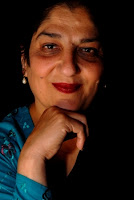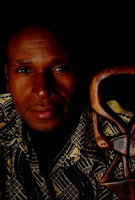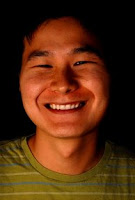
-- by Sara
The first thing that strikes you about Thom Hartmann in person is that he looks about 20 years younger than he actually is. The second is that he's got an energy level that's unbelievable.
"I got off the plane from DC at 3:15 this morning," he admits, apologizing for getting a name wrong in a story he was telling. "And I had to be on the air at six, so I'm running on very little sleep." It's now getting on toward two in the afternoon, and he's been speaking for 45 minutes, bouncing around the platform with energy and a recall of names, people, places, dates -- hundreds of years of American and English history -- that dazzles. If this is what he's like when he's been up all night, he must be hell on wheels when he's well-rested.
Hartmann's got a new book out (Screwed: The Undeclared War Against the Middle Class). Thursday afternoon, given the chance to preach to the faithful of the religious left, the themes of the book became the text of his sermon. It's obvious that the skill set that makes for good radio talkers is pretty much the same one that makes for good preachers; and Hartmann warms eagerly to the task.
Today, he's debunking three dominant myths that he argues are undermining the American middle class. Culture, he says, is nothing more than a collection of shared stories -- collected over long periods of time, reflecting a lot of our past experiences. Unfortunately, the stories we tell ourselves as Americans about what democracy is and what it means to us are fraught with myths. These stories are at the core of our thinking about democracy: we are living our lives and basing our decisions on the basis of stories that are, in fact, not true. And change will not occur until we puncture these stories in order to make room for new ones.
The first myth Hartmann wants us to puncture is the myth of the free market, which has been elevated to the level of a religion. He invoked Grover Norquist -- who famously said that he wanted to shrink government down to where he could drag it into the bathtub and drown it -- and noted that New Orleans was what ended up getting drowned instead.
"Why does the Bush administration replace competent people with ideologues?" asked Hartmann. The answer lies in the essence of the conservative worldview. Conservatives believe that corporations are morally neutral; but human beings are essentially evil. Given that equation, it's obvious that corporations are thus morally superior to human beings, and thus should be given greater rights and dominance. Government, on the other hand, expresses the will of the people -- and since people are inherently evil, government is inherently evil as well.
Liberals, on the other hand, generally agree on the moral neutrality of corporations; but they believe that people are fundamentally good. "This is the fundamental cleavage between these two world views," notes Hartmann, pointing out that this worldview is clearly reflected in the preamble to the Constitution. "Our founders' six stated purposes reflect this belief -- that government exists to lift people up to their highest potential." We provide for the common defense in order to protect ourselves from the handful of bad apples in the bunch; but the rest of the document, asserts Hartmann, is about maximizing human opportunity.
On the other hand: "The free market is just a euphemism for large multinational corporations controlling the planet," he concluded.
The second myth, says Hartmann, is that "those who grew up in the middle class in America think a middle class is a normal thing. This isn't true. The middle class is an aberration, not a norm." In every case of laissez-faire capitalism in history, he argues, what has resulted -- every time -- was a very small, preposterously wealthy ruling class; a relatively small middle class of professionals and trades; and a huge class of working poor.
"A middle class is not a normal thing. It has to be created." Historically, middle classes only emerge under unusual (and usually unstable) circumstances: in fact, there have only been four great middle class periods in the past 600 years. The first occurred in Europe around 1450, after a quarter to a third of the population died in the plague. This drove up the cost of labor; and this rise in wages created the first major European middle class. We now call this period the Renaissance; and it led to some of the earliest democracies in Europe.
In time, the European aristocracy pushed back with maximum wage laws and other means of destroying this emergent class; and feudalism gradually returned. But when the Spaniards discovered gold in the Americas (and the Dutch and others were trading elsewhere as well), the amount of wealth available dramatically increased. Wages went up, families grew richer, and another middle class formed. We now remember this period as the Enlightenment.
The third wave was the American settlement, in which relatively few people took lots of land (killing the residents who'd long husbanded a rich array of resources), and used them to create a prosperous middle class in both the US and Europe from the mid-1600s to the early 1800s. The upshot of this was the American Revolution. But once it was over, the upper classes reasserted themselves: from the 1830s through the early 1900s, we slipped back into feudalism.
To show how far that decline went, Hartmann pointed out that in 1900, the average American family made the modern equivalent of $9700 -- well below our current poverty line. Small business owners and family farmers struck back briefly through the Populist movement; and 30 years later, FDR codified their values in the New Deal, which reinvigorated the middle class once again.
Those of us who remember the American middle class as it existed between 1945 and 1985 find it hard to adjust to the idea that it doesn't exist any more. And, says Hartmann, we're right to be worried about it. "FDR got that a middle class is a) essential for democracy; and b) doesn't happen by accident. It isn't even normal."
Like earlier eras of middle-class dominance, the one just past was also a time of cultural renewal and unrest. Hartmann reminds us that conservatives consider the 60s a terrible aberration that must never be repeated -- and know that one way to keep it from repeating is to eliminate the middle class, thus reducing the number of agitators. "If you leave it to the corporate class, you will destroy the middle class. They know that when people are working 60-hour weeks, they don't have time to show up, be informed, or even vote." If the price of "social stability" is an entire nation of underpaid working poor, then it's a price our ruling classes are apparently all too happy to pay.
The third myth, according to Hartmann, is that we elect leaders in the United States. "We do not elect leaders…we elect representatives. We elect people to represent us." (And, looking at our leaders, it's sobering to consider just who and what it is that they represent.) "We can't sit around thinking some politician is going to save us….Congress, the Senate, the president, Ralph Nader's group -- none of them are going to do a thing until we push them into it. "
Politicians, Hartmann told us, don't initiate change. Invariably, they wait for a parade to form, and then get out in front of it and claim it as their own. "If enough of us create the parade -- I 100% guarantee it, because it's always happened this way -- some politician will run out in front of it, hoist up his flag, and say "This is my parade!"
So, concludes Hartmann: Like every generation of Americans before us, it's our turn to get out there and be the parade. The fate of the comfortable American middle class -- and the democratic government it supports -- hangs in the balance.











